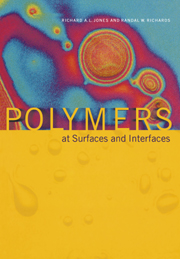Book contents
- Frontmatter
- Contents
- Preface
- 1 Introduction and overview
- 2 The surface of a simple polymer melt
- 3 Experimental techniques
- 4 Polymer/polymer interfaces
- 5 Adsorption and surface segregation from polymer solutions and mixtures
- 6 Tethered polymer chains in solutions and melts
- 7 Adhesion and the mechanical properties of polymer interfaces at the molecular level
- 8 Polymers spread at air/liquid interfaces
- Index
6 - Tethered polymer chains in solutions and melts
Published online by Cambridge University Press: 19 January 2010
- Frontmatter
- Contents
- Preface
- 1 Introduction and overview
- 2 The surface of a simple polymer melt
- 3 Experimental techniques
- 4 Polymer/polymer interfaces
- 5 Adsorption and surface segregation from polymer solutions and mixtures
- 6 Tethered polymer chains in solutions and melts
- 7 Adhesion and the mechanical properties of polymer interfaces at the molecular level
- 8 Polymers spread at air/liquid interfaces
- Index
Summary
Introduction
We saw in the last chapter that we can modify the properties of interfaces using polymers; for example, we can reduce the surface energy of a polymer melt by blending in a polymer of lower surface energy that segregates to the surface or we can modify a solid/liquid interface by the adsorption of a polymer at that interface. So far we have only considered simple homopolymers, but for a long time it has been realised that we can use cleverer polymer chemistry to design materials whose architecture leads to especially desirable interfacial properties. The basic idea of a surface-active polymer is the same as that for a small-molecule surfactant: we create a molecule in which various parts of the molecule have different affinities for the various parts of the interface. For example, to make a molecule that would modify the interface between two immiscible polymers we might make a diblock copolymer, composed of a sub-chain of each polymer type linked togther covalently (see figure 6.1). Such a molecule would at equilibrium segregate to the polymer/polymer interface, whose properties would thereby be modified. As we shall see, if they are carefully designed, such molecules are able to make huge changes to properties such as the interfacial energy, which can in some cases be reduced to zero, and the interfacial fracture toughness, which can be increased by more than an order of magnitude.
- Type
- Chapter
- Information
- Polymers at Surfaces and Interfaces , pp. 244 - 292Publisher: Cambridge University PressPrint publication year: 1999
- 3
- Cited by

